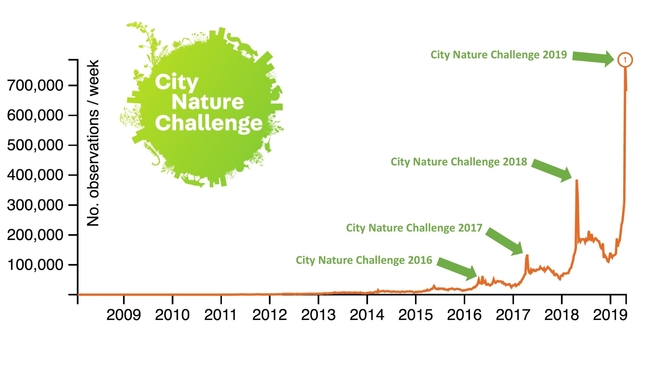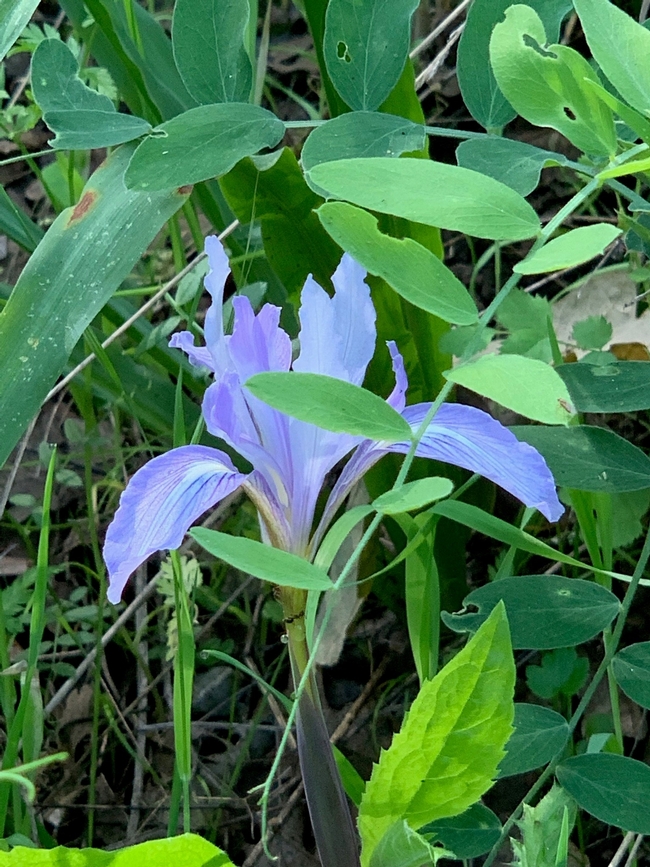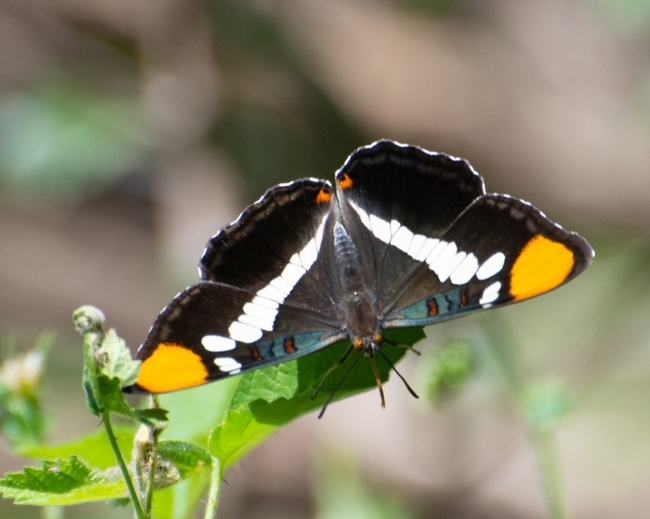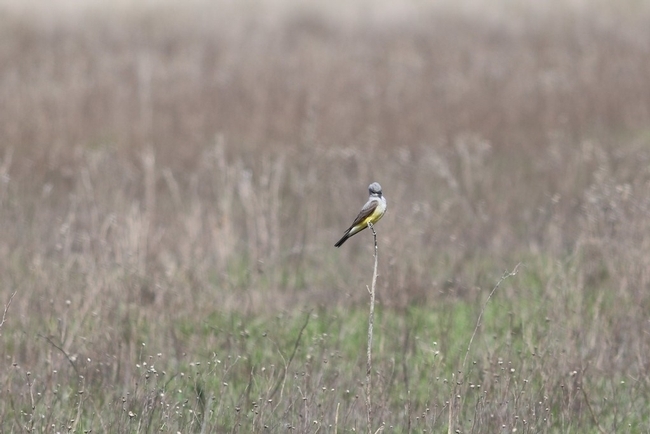Posts Tagged: inaturalist
Seen Any Monarchs Lately?
Seen any monarchs lately? No, not the British royal family: the monarch butterfly, Danaus plexippus. Butterfly guru Art Shapiro, UC Davis...
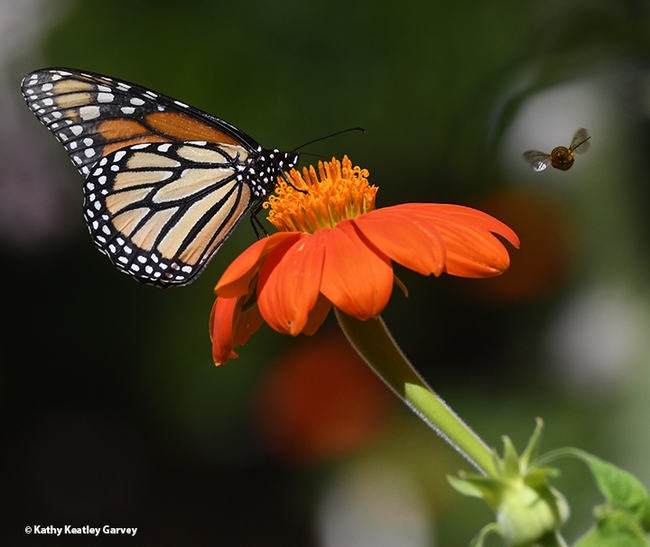
A territorial male bee, Melissodes agilis, targets a monarch nectaring on a Mexican sunflower, Tithonia rotundifola, in July 2020 in Vacaville, Calif. (Photo by Kathy Keatley Garvey)
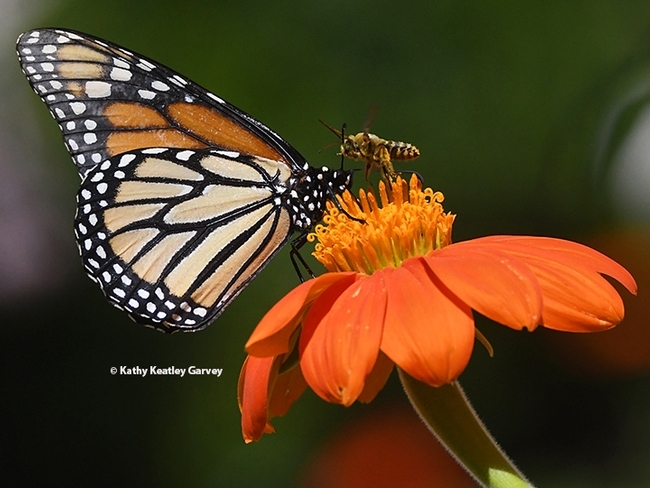
A territorial male bee, Melissodes agilis, confronts a monarch nectaring on a Mexican sunflower, Tithonia rotundifola, in July 2020, in Vacaville, Calif. (Photo by Kathy Keatley Garvey)
The City Nature Challenge: A win for science and nature
All of our certified California Naturalists know how to use iNaturalist. Since uploading at least one observation is part of the course requirements, the City Nature Challenge was the perfect opportunity for Naturalists to reconnect with each other, offer their skills to their city's efforts, and contribute to a global scientific database.
The 4th annual City Nature Challenge was a huge success around the world. Together with the 159 cities that participated, we uploaded almost one million observations of biodiversity to iNaturalist in just 4 days. More than 35,000 people took part across the globe, and over 31,000 species were documented, including more than 1,100 rare, endangered, or threatened species.
This was also the biggest week for observations recorded in iNaturalist history, as demonstrated in the graph below.
With the San Francisco Bay Area, Los Angeles County, and San Diego County organizers publicizing the Challenge for their cities and working to highlight events, we wanted a chance for our Sacramento Region Naturalists to join the fun, too. Beginning in September of 2018, we co-organized for the Sacramento Region with Ryan Meyer and Julianna Yee from the UC Davis School of Education's Center for Community and Citizen Science, our UC Davis Evolution and Ecology California Naturalist instructor Laci Gerhart-Barley, and environmental educator Chelle Temple-King.
The California Naturalist program wants to recognize the contributions of our Naturalists to their city's final counts. We know many of you were out there at bioblitzes or in your backyards taking photos all weekend, and celebrate all that you contributed to science and nature. Congratulations on your achievements both large and small! We want to take a moment to highlight a few of our certified Naturalists, instructors, and partners for their involvement this year:
- Partners that held Bioblitzes outside of city boundaries over the weekend: Hopland Research & Extension Center, UC Santa Cruz Arboretum
- Sacramento Region CalNat partners: Many thanks to American River Conservancy, Yolo Basin Foundation, Effie Yeaw Nature Center, and UC Davis' Wild Davis for organizing Bioblitzes as first year guinea pigs
- Bay Area CalNat partners: thanks to Sonoma Ecology Center for a Bioblitz and Grassroots Ecology for contributing observations during their class field trip
- Certified California Naturalist Cedric Lee as the number one observer for Los Angeles County!
- Certified California Naturalist and Tuleyome instructor Mary Hanson came in 5th for the Sacramento Region; UC Davis' Wild Davis instructor Laci Gerhart-Barley and 3 current CalNat students came in the top 10
- Certified California Naturalist Millie Basden came in 8th for San Diego County
- Certified California Naturalist Amy Jaecker-Jones is a co-organizer for the international City Nature Challenge through the Natural History Museum of Los Angeles County
Despite the final results, the real winner of the City Nature Challenge is science and nature. A database holding a greater number of research-grade observations to draw from allows scientists to further study our natural world. You can take a look at publications that have used data from iNaturalist to see just where our contributions are going. And of course, the more people who get outside during the Challenge, the more people engage with the nature around them. Everybody wins!
Highlights of San Francisco Bay Area City Nature Challenge 2019:
- 1st place for number of observers with 1,947 (This includes more than 550 observers who were new to iNaturalist)
- 1st place for number of identifiers with 813
- 4th place for number of observations with 38,028
- 5th place for number of species found at 3,183
- Participants submitted anywhere from 1 to 698 observations
- Most observed species: California poppy (Eschscholzia californica)
Highlights of Los Angeles County City Nature Challenge 2019:
- Los Angeles had the greatest increase in number of observations over last year: increase of 14,702 observations!
- Los Angeles had the greatest increase in number of people observing over last year: increase of 700 people!
- Over 1/3 of our observers were new to iNaturalist in the two weeks before CNC began
Highlights of Sacramento Region City Nature Challenge 2019:
- Overall, Sacramento came in 30th out of 159 participating cities
- Of 27 the other participating cities with a population of 2,500,000-5,000,000, Sacramento came in 9th
- In all of 2019 leading up to the Challenge, post-Challenge our region was able to increase the number of observations by 7.8% (9832 observations), species by 2% (124 species), and observers by 3.5% (233 observers).
- Sacramento came in 5th for the number of total observers for a region > 20,000 km2
- For all the observations we collected in the Sacramento region, 57% ID'd to species became research grade (or useable for scientific quality data).
For the naturally curious
 Whether you are enjoying a family day at the beach or a hike through the woods, the pictures you take not only document your memories, but they also capture observations in nature. The relatively new website, iNaturalist, creates a forum for the public to be able to share those photos as a living record of our environment.
Whether you are enjoying a family day at the beach or a hike through the woods, the pictures you take not only document your memories, but they also capture observations in nature. The relatively new website, iNaturalist, creates a forum for the public to be able to share those photos as a living record of our environment.
iNaturalist works in three different ways. You can post your own observations by creating a free account and uploading a picture of a beautiful patch of wildflowers or a type of bird you have never seen before. Other users can then comment on your photo and also help you identify the species you observed. You can also use the site to explore your neighborhood, community, or state by using the map to see where recent observations have been made or search by species to view the beautiful and strange creatures captured on camera. Lastly, you can create or join a project to pool your observations with others and help land managers and scientists track changes in biodiversity.
iNaturalist differs from other recent web-based resources out of the University of California to collect natural resource data from the public because it functions as a place for the public to learn about the environment around them through a collaborative social platform. It is also different in its environmental application since it does not focus specifically on invasive species, such as UC Berkeley’s Oakmapper and UCLA’s What’s Invasive, but all species of plant and wildlife.
First conceived as the Master's final project of Nate Agrin, Jessica Kline, and Ken-ichi Ueda at UC Berkeley's School of Information, iNaturalist was established in 2008. Currently Ken-ichi maintains the site in collaboration with Scott Loarie, a climate change researcher at the Carnegie Institution. An iphone app hit stores this past February so people can make photo observations on the go and upload pictures they take on their phone directly to the site.
“Having an app is important,” Ken-ichi notes. “We’re such a good platform for citizen science monitoring efforts and the app definitely enhances this ability.”
Two projects that stand out with regular contributors include the Pepperwood Monitoring Project on the Pepperwood Preserve and the Jasper Ridge Preserve Project on the Jasper Ridge Biological Reserve, both of which focus on tracking plant and animal data on their properties.
Currently the site has just under 1,000 registered users with an average of 100 to 150 unique users entering the site everyday and over 13,600 observations. So no matter if environmental science is your professional field, your passion, or you need help identifying the weeds that keep growing in your yard, iNaturalist is a helpful learning tool.
For more information or to join iNaturalist, please visit inaturalist.org. The iNaturalist app can be downloaded for free from the iTunes app store.


